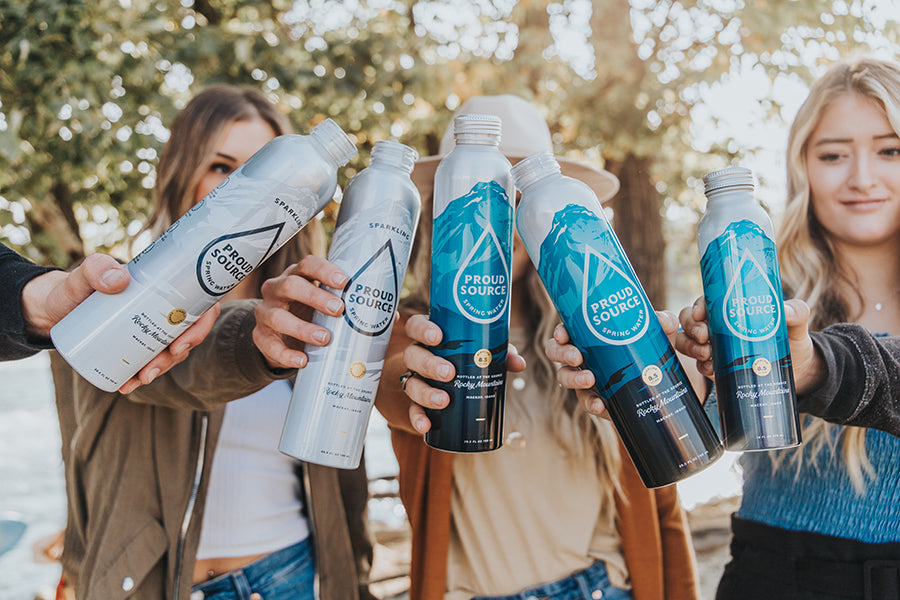Your cart is empty

Reduce, Reuse, & Recycle. Three words ingrained in our heads throughout our entire life and, if done in the right way, can have a tremendous positive impact on the environment. The problem is, recycling is a complicated system, and there is still so much confusion about what happens to our waste after it’s put into the recycling bin.

Since Proud Source Water’s launch at Treefort Music Fest in Boise 3 years ago, our team has learned an immense amount about sustainable practices and the recycling industry. Our involvement in over 50 events since we first launched in 2017 has led to eye opening conversations, particularly around plastic bottled water vs. aluminum.
We often hear, “I do my part and recycle my plastic bottles,” and “plastic water bottles are easy on the environment because they are recyclable.” Like many of the people we have interacted with, we too previously believed plastic bottles could be recycled an infinite number of times. And, when recycled, they could eventually be made into another bottle. Unfortunately, that’s not the case.
Unlike aluminum, plastic is not infinitely recyclable. In fact, most plastics can only be recycled once, maybe twice, before downcycled and eventually ending up in our environment.

Plastic bottle in the ocean
With the clear misconception about the recyclability of plastic bottles and other materials, we wanted to learn more about the recycling industry, and how we can improve the way we dispose of waste. We visited our local recycling center and spoke with one of the managers, Kasey. He opened our eyes to some of the truths behind recycling. (See IGTV- The Truth About Recycling)
One of the biggest issues centers around the fact that recycling is not a universal system. What is recyclable in one community may not be accepted in another. Guidelines for accepted materials differ among locations. This leads to a lot of misunderstanding regarding the materials your local recycling facility accepts.
Several factors determine what materials are accepted at each facility including-
Check your local facilities website for more specific guidelines. This will help Recycling facilities keep their doors open and make all the difference.
Once materials arrive at the facility, they are distributed onto a conveyor belt. Workers sort through materials and remove all unwanted trash items, including styrofoam, plastic bags, clothes hangers, toys, electronics. The team we interviewed has even removed animal carcasses and many dirty diapers - unfortunately, the list went on and on.
We asked Kasey, the facility manager, the effect that unwanted items have on his facility and he said, “it makes the whole recycling process go south. If they aren’t going to do it right, I just rather them not do it.” His response made it clear that there is a lack of understanding around recycling and he must deal with the repercussions daily.

Recycle center
After sorters remove unwanted material, the equipment then separates the recyclables (cardboard, paper, aluminum, plastic). Once separated, material is sent to the balers, where materials are compressed into bales and transported to various recycling facilities throughout the U.S.
Many facilities equipment lack advanced technology. During the sorting process, older machines will automatically mistake some of the plastic material for paper or cardboard. This results in plastic being mixed in with the cardboard and paper bales. After selling the bales of material, recyclers will often reject the shipment and send it back to the original facility based on having too many contaminates. As Kasey mentioned, “most of these contaminates are plastic.”
“This is the answer to a lot of our problems,” Kasey explained as he pointed to his PSW bottle. “If you could get the majority of people drinking that, it would be good. People would be recycling their aluminum cans again.”

Proud Source Water's infinitely recyclable aluminum bottles
100% aluminum bottles can help make municipal recycling programs possible. Many recycling facilities rely on re-selling recycled material. The high value of aluminum in the recycling stream can help subsidize the recycling of less valuable materials, such as plastic.
It’s a ripple effect.
To lessen the production of plastic, we need to stop buying plastic. Once our plastic consumption decreases, companies must provide sustainable options, making plastic bottled water a thing of the past.
“Our front door used to be really busy back in the day. This would jump start everything,” explained Kasey. “Plastic waste decreasing and aluminum increasing would mean less rejections, and result in more profit for recycling facilities and less waste ending up in landfills/the ocean.”
Recycling isn't just about putting your recyclables in the bin. It’s also about purchasing recycled products. There is still such a high level of effort that needs to be done and recycling is a team effort. Communities need to continue to become aware of how they can work together to support one another and ultimately, make our world a better and cleaner place.
Author- Kaloni Pennington